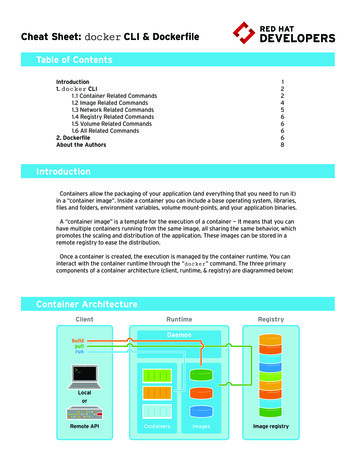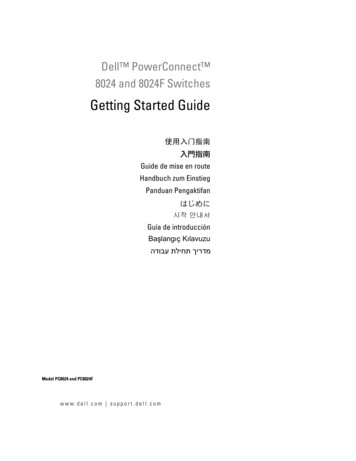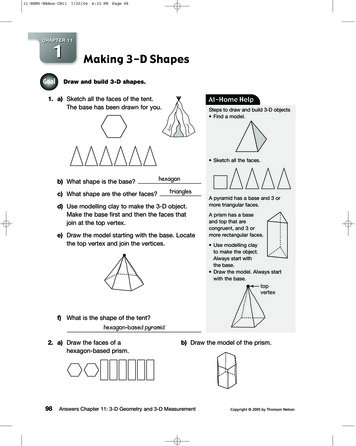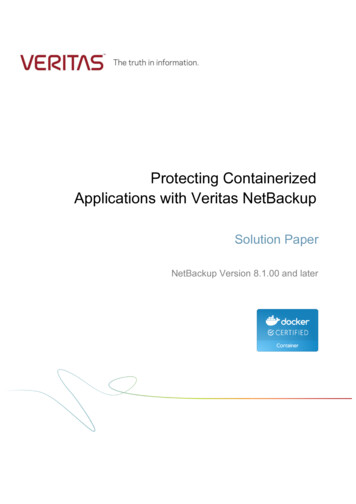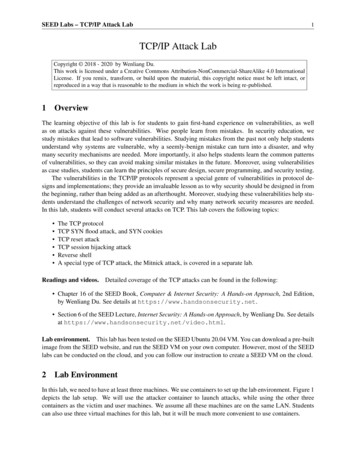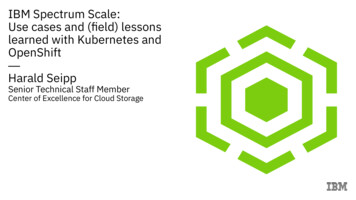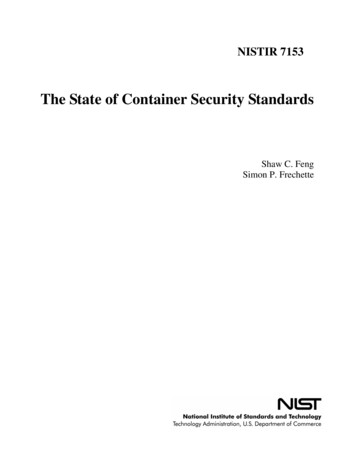
Transcription
NISTIR 7153The State of Container Security StandardsShaw C. FengSimon P. Frechette
NISTIR 7153The State of Container SecurityStandardsShaw C. FengSimon P. FrechetteManufacturing Engineering LaboratoryOctober 2007U.S. Department of CommerceCarlos M. Gutierrez, SecretaryNational Institute of Standards and TechnologyJames M. Turner, Acting Director
Table of Contents1. Introduction. 22. Container Security Standards Requirements . 23. The Current State of Standards for Container Security . 33.1 Standard Development Organizations . 53.2 Containers . 73.2.1 Physical Security. 73.2.2 Container Identification Technology . 93.3 Transportation . 133.3.1 Vehicle Identification. 133.3.2 Transportation identification. 143.4 Port Access. 163.5 Communication in Supply Chain. 173.5.1 Medium and Long-Range Communication . 173.5.2 Supply Chain Security . 184. Conclusion . 20Acknowledgements. 21References. 211
1. IntroductionAbout seven million containers arrive at U.S. ports every year. Almost 95% of U.S.bound cargo moves by containers [3]. Currently, U.S. Customs officials use advancedtechnologies to identify and prescreen high-risk containers. The Department of HomelandSecurity has issued security guidelines for U.S. agencies, carriers, and importers in theCustoms Trade Partnership Against Terrorism (C-TPAT). C-TPAT encourages importersand carriers to certify their cargo sources and assume responsibilities for cargo security[1].The RAE report [3] stresses the importance of integrating sensor networks with supplychain databases and existing import/export processes to allow global traders to manageand monitor their maritime cargo in transit. Effective sensor technology and integratedinformation systems will be critical components of a comprehensive container inspectionsystem. Data communication standards play a key role in direct data flow from sensors,electronic seals, and identification (ID) tags to location tracking and other systems usedto provide overall shipping security.Deployment of advanced container security technology is impeded by the lack of syntaxand semantics standards for data exchange. This has led to proprietary solutions that workat isolated locations, but cannot be tied together for seamless data flow and dataverification. Aside from the costs incurred by manually handling the same data numeroustimes and the errors that inevitably result, the lack of standards inhibits the deployment oftruly intelligent systems that can leverage today’s computer technology. Such technologypromises the ability to track a container’s history, pinpoint security breaches, recognizeemerging patterns and anomalies, and automatically alert the downstream and upstreamtransit points.This report focuses on the standards needed to integrate security device outputs and cargoprocessing information into supply chain information systems. It provides a survey of thestate of the art in standards that address container security.2. Container Security Standards RequirementsBoth the Container Security Initiative (CSI) [1] and C-TPAT have raised new securityrequirements on cargo container standards. Physical integrity, communication betweensensors, identification methodologies including Radio Frequency Identification (RFID),supply chain systems, and container shipping information repository systems are withinthe scope. The following information standard needs can be derived from CSI and CTPAT. Specification of physical/structural security Seal tampering detection and reporting Tracking, tracing, and condition reporting Unique identifying importer, carrier, and cargo source2
Communication between electronic seals, RFID, and supply chain securitydatabases Shipping route, including stops and departure/arrival dates Originator, transporters, recipient, cargo inspectors, and other containerhandlers and their security certifications Sequence of custodianship transfers, including transferring date, place,inspection, and other relevant information3. The Current State of Standards for Container SecurityAll the currently available standards address the security of containers in transit. Acontainer contains products that are ordered by clients and manufactured by a supplier.The container is transported by truck, trains, or ship. At each national boundary, thecontainer has to be checked by customs. While in transit, the container is usually trackedby using satellite or land-based communication. Electronic door seals, radio frequencyidentification tags, supply chain tags, vehicle identification tags, and container shipidentification devices are used to provide real-time container identification, location, andintrusion detection. As shown in Figure 1, containers to be shipped overseas are loadedand then transported to a customs check point at a sea port.Standard Development Organizations (SDOs) are described in Section 3.1. Currentlyavailable port access security standards are described in Section 3.4. The cargo ownerand shipper can track the container using land-based and satellite-based methods.Satellites provide real-time location and communication capabilities. Communication andair-interface standards are described in Section 3.5. At a sea port, the container is loadedto a container ship. The container goes through customs and port security check on landat the port of origin. At the destination, the container is loaded off from the ship to adelivery vehicle. The container could be loaded to different modes of transportation onland, such as truck, trailer, or train. It might also be temporarily off loaded for storageduring intermodal transportation. Supply chain security standards including eBusinessstandards and management system standards are described in Section 3.5.2.Technical areas in container and vehicle security standards are shown in Figure 2. Thosestandards address both physical security and identification. Physical security includeselectronic and mechanical door seals and structural integrity. Container identification (ID)has in two categories: individual container ID and supply chain ID. Details are describedin Section 3.2. Also, details of vehicle-related security standards (tagging, registration,and intermodal transportation) are described in Section 3.3.3
Figure 1 Container in a supply chainFigure 2 Container and vehicle security4
3.1 Standard Development OrganizationsMost available standards were developed under the auspices of the InternationalOrganization for Standardization (ISO) [4]. The standards can be categorized by theirfunctions as follows: container security, transportation security, port security, and supplychain communication security. The goal of standards development is to have a completeset of standards that are critical to the security of the supply chain, from origin to finaldestination. Many available ISO standards are listed in the ascending order of thestandard number starting on [7] in References; a complete list of such standards is beyondthe scope of this report. It is the authors’ intent to keep updating this report as newstandards become available.There are generally six stages in the development of an ISO standard. The first stage isstandard proposal. A new work item proposal (NP) is submitted for vote by members ofthe relevant Technical Committee (TC) or Subcommittee (SC) to determine the inclusionof the newly proposed work time. The second stage is standard preparation. A workinggroup of technical experts, led by a project leader, prepare a Working Draft (WD) untilthe working group is satisfied that it has developed the best possible solution to solve theproblem being addressed. The draft is thus forwarded to the parent committee forconsensus building. The third stage is committee stage. The working draft is registered bythe ISO Central Secretariat as a Committee Draft (CD) and distributed for comment.Successive CD revisions may be necessary until consensus is reached. Sometime, votingby qualified voting members takes place to reject the CD if consensus cannot be reached.Once consensus has been attained, the document is finalized for submission as a DraftInternational Standard (DIS). The fourth stage is enquiry. The DIS is circulated for allISO members for voting and comment within a specified period. It may be approved forsubmission as a Final Draft International Standard (FDIS) or disapproved and returned tothe committee for rework. The fifth stage is approval. The FDIS is circulated to all ISOmember bodies for the final approval. The sixth stage is publication. Once the FDIS hasbeen accepted by ISO, the final text is published as an International Standard (IS). Thosedraft standards that consensus is not attained can be published as a Technical Report (TR),Technical Specification (TS), or Publicly Available Specification (PAS), decided by theworking group, SC, or TC to publish the useful information. They follow a less rigorousreview and approval process than that of an IS.An IS can be amended later. Amendment (Amd) is attached to the IS title. In addition toISO, The International Electrotechnical Commission (IEC) [5] forms the Joint TechnicalCommittee (JTC) with ISO to developed standards of common interests.ISO committees that develop container security-related standards are as follows.ISO/TC8 (Ships and Marine Technology) develops standards for shipbuilding, shipoperations, sea-going ships, vessels for inland navigation, offshore structures, ship-toshore interfaces, and other marine structures required by the shipbuilding industry.Shipbuilding standards address design, construction, structural elements, outfitting parts,equipment, methods and technology, and marine environmental matters.5
ISO/TC 104 (Freight containers) develops standards of terminology, classification,dimensions, specifications, handling, test methods, and marking for freight containersthat have an external volume of at least one cubic meter.ISO/TC 122 (Packaging) develops standards in the field of packaging with regard toterminology and definitions, packaging dimensions, performance requirements, and tests.ISO/TC 104/TC 122 Joint Working Group develops standards for supply chainapplications of RFID for packages, means of packaging, and unit loads. These standardsaddress technical areas of performance requirements and tests.ISO/TC 154 (Processes, data elements and documents in commerce, industry andadministration) develops standards for business transactions, administration processes,and global supply chain supporting data.ISO/TC 204 (Intelligent transport systems) develops standards for information,communication, and control systems for urban and rural surface transportation, includingtraveler information, traffic management, public transport, commercial transport,emergency services, and commercial services. The standards address issues in bothintermodal and multimodal transportation.ISO/IEC JTC1/SC17 (Cards and personal identification) develops standards in thefollowing technical areas: physical characteristics and test methods for ID cards, machinereadable ID cards, integrated circuit card with or without contacts, registrationmanagement, optical memory cards and devices, motor vehicle driver licenses, andapplications of biometrics to cards and personal identification.JTC1/SC 31 (Automatic identification and data capture techniques) develops standards inthe technical areas of data carrier, data structure, conformance tests, RFID for itemmanagement, and real time locating systems.JTC1/SC 37 (Biometrics) develops standards in the technical areas of harmonizedbiometric vocabulary, biometric system interface, biometric data interchange formats,biometric functional architecture and profiles, and biometric software testing andreporting.In addition to ISO and IEC, the World Customs Organization (WCO) is an independentintergovernmental organization that is to coordinate Customs administrations amongcountries. With 169 Member Governments, it is the only intergovernmental worldwideorganization competent in Customs matters. WCO has the following primary functions: harmonization and uniform application of agreed Customs systems and proceduresgoverning the movement of commodities, people, and conveyances across Customsfrontiers, Reinforcement of Members’ compliance with their legislation and co-operation tocombat Customs and other transnational offences, and6
Promotion of communication and co-operation among Members and with otherinternational organizations, and by fostering integrity, human resource development,transparency, improvements in the management and working methods of Customsadministrations and the sharing of best practices.WCO has developed a Framework of Standards to Secure and Facilitate Global Trade in2005 [6].The International Maritime Organization (IMO), formerly known as the InterGovernmental Maritime Consultative Organization (IMCO), was established in 1948through the United Nations to coordinate international maritime safety and relatedpractices. However, the IMO did not enter into full force until 1958. The organizationpromotes cooperation among governments and the shipping industry to improve maritimesafety and to prevent marine pollution. IMO is governed by an Assembly of members andhas other functions of marine safety and environmental protection.The International Container Bureau is an organization with the goal to unite corporationsor government units that handle, process, transport, and inspect freight containers. It hasseveral publications and is responsible for the Bureau International des Conteneurs (BIC)codes, which constitute the standard ISO 6346 [10] coding system for every containerowner and container operating company. The Bureau is located in Paris, France.The World Shipping Council is a trade association representing more than forty linershipping companies serving America's international trade. Located in Washington, D.C.,members include container lines and carriers. In addition to ocean transportation,members provide a wide range of intermodal and logistics services to Americanimporters and exporters. Issues addressed by the Council include maritime security,regulatory policy, safety, harbor dredging, and upgrading the shipping infrastructure.The developed container security-related standards are described in the followingsections.3.2 ContainersContainer standards are categorized into physical security and container identificationtechnology. A vocabulary for freight containers is specified in ISO 830 [7].3.2.1 Physical SecurityPhysical security includes door security, structural integrity, and seals. Standards for doorsecurity are in ISO 1496 Part 1. Standards for container structural integrity and tests arespecified in ISO 15070 and Amendment 1. Recently, standards for container seals havebeen developed. They include ISO 17712 for bolt locks and the ISO 18185 series forelectronic seals [2].7
Cargo Container Physical SecurityDoorStatusISO 1496 Series 1 freight containers - Specification andtesting - Part 1: General cargo containers for generalpurposes [8]ISO/TC104 ISISO 1496 Part 1/Amd 5:2006 Door end security [9]ISO/TC104 ISISO 15070 Series 1 freight containers - Rationale forstructural test criteria [32]ISO/TC104 TRISO 15070/Amd 1 Guidance on structural integrity [33]ISO/TC104 TRISO 15070/Amd 2 Design Consideration [34]ISO/TC104 CDMechanical ISO 17712 Freight containers - MechanicalSeals [57]ISO/TC104 PASElectronicSealSDOISO 18185 Freight containers - ElectronicISO/TC104 FDISseals - Part 1: Communication protocol [71]ISO 18185 Freight containers - Electronicseals - Part 2: Application requirements[72]ISO/TC104 FDISISO 18185 Freight containers - Electronicseals - Part 3: Environment characteristics[73]ISO/TC104 ISISO 18185 Freight containers - Electronicseals - Part 4: Data protection [74]ISO/TC104 FDISISO 18185 Freight containers - Electronicseals - Part 5: Sensor interface [75]ISO/TC104 FDISISO 18185 Freight containers - Electronicseals - Part 6 Message sets for transferbetween seal reader and host computer [76]ISO/TC104 CDISO 18185 Freight containers - Electronicseals - Part 7 Physical layer [77]ISO/TC104 DIS8
3.2.2 Container Identification TechnologyRadio Frequency Identification (RFID) technology is available for containeridentification. There are standards for air interfaces, implementation guidelines, systemmanagement, data content, data protocol, and performance tests for RFID used oncontainers.SDOStatusISO/IECJTC1/SC31ISISO/IEC 18000 Information Technology Radio frequency identification for itemISO/IECmanagement - Part 2: Parameters for airJTC1/SC31interface communication below 135 kHz [59]ISISO/IEC 18000 Information Technology Radio frequency identification for itemmanagement - Part 3: Parameters for airinterface communication below 13,56 MHz[60]ISO/IECJTC1/SC31ISISO/IEC 18000 Information Technology Radio frequency identification for itemmanagement - Part 4: Parameters for airinterface communication below 2,45 GHz[61]ISO/IECJTC1/SC31ISISO/IEC 18000 Information Technology Radio frequency identification for itemmanagement - Part 6: Parameters for airinterface communication at 860 MHz to 960MHz [62]ISO/IECJTC1/SC31ISISO/IEC 18000 Part 6/Amd 1 Extension withType C and update of Types A and B [63]ISO/IECJTC1/SC31ISISO/IEC FDIS 18000 Informationtechnology - Radio frequency identificationfor item management - Part 7: Parameters foractive air interface communications at 433MHz [64]ISO/IECJTC1/SC31FDISRFIDISO/IEC Information Technology – Radiofrequency identification for itemmanagement - Part 1: Reference architectureand definition of parameters to bestandardize [58]Air interfaceISO 24753 Automatic Identification and Data ISO/IECJTC1/SC31Capture Techniques - Radio Frequency9NP
SDOStatusISO/IEC 24729 Information technology Radio frequency identification for itemmanagement - Implementation guidelines Part 1: RFID-enabled labels [109]ISO/IECJTC1/SC31TR,CDISO/IEC 24729 Information technology Implementation Radio frequency identification for itemmanagement - Implementation guidelines guidelinePart 2: Recyclability of RF tags [110]ISO/IECJTC1/SC31TR,CDISO/IEC 24729 Information technology Radio frequency identification for itemISO/IECmanagement - Implementation guidelines JTC1/SC31Part 3: RFID interrogator/antenna installation[111]TR,NPISO/IEC 24791 Information technology Automatic Identification and Data CaptureTechniques - Radio-Frequency Identification(RFID) for Item Management - SystemManagement Protocol [117]ISO/IECJTC1/SC31NPISO/IEC 15418 Information technology EAN/UCC application identifiers and factdata identifiers and maintenance [35]ISO/IECJTC1/SC31ISISO/IEC 15424 Information technology Automatic identification and data capturetechniques - Data carrier identifiers [36]ISO/IECJTC1/SC31ISISO/IEC 15434 Information technology Automatic identification and data capturetechniques - Syntax for high-capacity ADCmedia [37]ISO/IECJTC1/SC31ISISO/IEC 15459 Information technology ISO/IECUnique identifiers - Part 1: Unique identifiersJTC1/SC31for transport units [38]ISISO/IEC 15459 Information technology Unique identifiers - Part 2: Registrationprocedures [39]ISO/IECJTC1/SC31ISISO/IEC 15459 Information technology ISO/IECUnique identifiers - Part 3: Common rules forJTC1/SC31unique identifiers [40]ISRFIDIdentification (RFID) for Item Management Air Interface for Battery Assist and SensorFunction [116]SystemmanagementData content10
SDOStatusISO/IEC 15459 Information technology Unique identifiers - Part 4: Unique identifiersfor supply chain management [41]ISO/IECJTC1/SC31ISISO/IEC 15459 Information technology Unique identification of transport units - Part5: Unique identification of returnabletransport items (RTIs) [42]ISO/IECJTC1/SC31FCDISO/IEC 15459 Information technology Unique identification of transport units - Part6: Unique identification for productgroupings in material lifecycle management[43]ISO/IECJTC1/SC31FCDISO/IEC 15961 Information technology Radio frequency identification (RFID) foritem management - Data protocol:application [44]ISO/IECJTC1/SC31ISISO/IEC 15962 Information technology Radio frequency identification (RFID) foritem management - data protocol – encodingrules and logical memory functions [45]ISO/IECJTC1/SC31ISISO/IEC 15963 Information technology Radio frequency identification for itemmanagement – unique identification for RFtags [46]ISO/IECJTC1/SC31ISISO/IEC 18046 Information technology Automatic identification and data capturetechniques - Radio frequency identificationdevice performance test methods [65]ISO/IECJTC1/SC31ISISO/IEC 18047 Information technology Radio frequency identification deviceconformance test methods - Part 2: Testmethods for air interface communicationsbelow 135 kHz [66]ISO/IECJTC1/SC31TRISO/IEC TR 18047 Information technology Radio frequency identification deviceconformance test methods - Part 3: Testmethods for air interface communications at13,56 MHz [67]ISO/IECJTC1/SC31TRISO/IECTRRFIDData protocolPerformancetestsISO/IEC 18047 Information technology –11
SDORFIDRadio frequency identification deviceconformance test methods - Part 4: Testmethods for air interface communications at2,45 GHz [68]StatusJTC1/SC31ISO/IEC TR 18047 Information technology Radio frequency identification deviceconformance test methods - Part 6: Testmethods for air interface communications at860 MHz to 960 MHz [69]ISO/IECJTC1/SC31TRISO/IEC TR 18047 Information technology Radio frequency identification deviceconformance test methods - Part 7: Testmethods for active air interfacecommunications at 433 MHz [70]ISO/IECJTC1/SC31TRAn RFID tag can be attached to a container to identify it as a unit, and multiple RFIDtags can be attached to individual packages to identify the goods in the container formonitoring, tracing, and tracking.Container Identification in a Supply ChainSDOStatusISO/TC104ISISOJTC104/TC122CDISO 17363 Supply chain application ofRFID - Freight Containers [51]ISO TC122DISISO 17364 Supply chain applications ofRFID - Returnable transport items [52]ISO TC122DISISO 17365 Supply chain applications ofRFID – Transport units [53]ISO TC122DISISO 17366 Supply chain applications ofSupply chain ID RFID – Product Packaging [54]ISO TC122DISISO/DIS 17367 Supply chain applicationsof RFID – Product tagging [55]ISO TC122DISISO/FDIS 17687 Transport InformationSystems - General Fleet Management andCommercial Freight Operations - Datadictionary and message sets for electronicidentification and monitoring of hazardousISO/TC 204FDISContainer IDISO 6346 Freight container - Coding,Identification and Marking [10]ISO 10374 Freight container – RFAutomatic Identification [21]12
Container Identification in a Supply ChainSDOStatusmaterials/dangerous goods [56]Sensors can be placed in a container to detect abnormal vibrations and temperaturechanges. An electronic seal is a type of sensor that detects and reports tampering.3.3 TransportationIn transportation, standards for automatic vehicle identification and personnelidentification are available.3.3.1 Vehicle IdentificationRadio Frequency (RF) identification-related standards are applicable for land-basedcontainer carriers, such as trucks and trains. Applications include tractor tagging, chassistagging, vehicle registration, and intermodal goods transport.Vehicle SO 14814 Road transport and traffic telematics Automatic vehicle and equipment identification Reference architecture and terminology [29]ISO/TC204ISISO 14815 Road transport and traffic telematics Automatic vehicle and equipment identification System specifications [30]ISO/TC204ISISO 14816 Road transport and traffic telematics Automatic vehicle and equipment identification Numbering and data structure [31]ISO/TC204TSISO 24531 Intelligent transport systems - Systemarchitecture, taxonomy and terminology - UsingXML in ITS standards, data registries and datadictionaries [95]ISO/TC204FDISISO/CD 24533 Transport information and controlsystems - Data dictionary and message set tofacilitate the movement of freight and itsintermodal transfer - Road transport informationexchanges [96]ISO/TC204CDISO 24534 Automatic vehicle and equipmentidentification - Electronic RegistrationIdentification (ERI) for vehicles - Part 1:Architecture [97]ISO/TC204TS,CD13
Vehicle CD TS 24534 Automatic vehicle andequipment identification - Electronic RegistrationIdentification (ERI) for vehicles - Part 2:Operational requirements [98]ISO/TC204TS,CDISO/CD TS 24534 Automatic vehicle andequipment identification - Electronic RegistrationIdentification (ERI) for vehicles - Part 3: Vehicledata [98]ISO/TC204TS,CDISO/CD TS 24534 Automatic vehicle andequipment identification - Electronic RegistrationIdentification (ERI) for vehicles - Part 4: Securecommunications using asymmetrical techniques[100]ISO/TC204TS,CDISO 24535 Intelligent transport systems Automatic Vehicle Identification - Basicelectronic registration identification [101]ISO/TC204TS,DISISO 17261, Intelligent transport systems Automatic vehicle and equipment identification Intermodal goods transport architecture andterminology [47]ISO/TC204TSISO/TS 17262 Intelligent transport systems Automatic vehicle and equipment identification Intermodal goods transport - Numbering and datastructures [48]ISO/TC204TSISO/TS 17263 Intelligent transport systems Automatic vehicle and equipment identification Intermodal goods transport - System parameters[49]ISO/TC204TSISO/CD TS 17264 Road transport and traffictelematics - Automatic vehicle and equipmentidentification – Interfaces [50]ISO/TC204TS,CD3.3.2 Transportation identificationTransportation ID standards specify electronic ID cards, biometric data, and personalprofile data exchange.14
Transportation IdentificationID cardSDOStatusISO/IEC 24727 Identification cards - Integratedcircuit card programming interfaces - Part 1:Architecture [104]ISO/IECJTC1/SC17ISISO/IEC FCD 24727 Identification cards Integrated circuit card programming interfaces Part 2: Generic card interface [105]ISO/IECJTC1/SC17FCDISO/IEC CD 24727 Identification cards Integrated circuit card programming interfaces Part 3: Application interface [106]ISO/IECJTC1/SC17CDISO/IEC NP 24727 Identification Cards Programming Interfaces for Integrated CircuitCards - Part 4: API administration [107]ISO/IECJTC1/SC17NPISO/IEC NP 24727 Identification Cards Programming Interfaces for Integrated CircuitCards - Part 5: Testing [108]ISO/IECJTC1/SC17NPISO/IEC NP 24749 Identification cards - Secureand interoperable IC card transaction device[108]ISO/IECJTC1/SC17NPISO/IEC 14443 Identification cards - Contactlessintegrated circuit(s) cards - Proximity cards - Part1: Physical characteristics [22]ISO/IECJTC1/SC17ISISO/IEC 14443 Identification cards - Contactlessintegrated circuit(s) cards - Proximity cards - Part2: Radio frequency power and signal interface[23]ISO/IECJTC1/SC17ISISO/IEC 14443 Identification cards - Contactlessintegrated circuit(s) cards - Proximity cards - Part3: Initialization and anticollision [25]ISO/IECJTC1/SC17ISISO/IEC 14443 Identification cards - Contactlessintegrated circuit(s) cards - Proximity cards - Part4: Transmission protocol [28]ISO/IECJTC1/SC17ISISO/IEC 14443/Amd 1:2005 Bit rates of fc/64,fc/32 and fc/16 [24]ISO/IECJTC1/SC17ISISO/IEC 14443/Amd 3:2006 Handling ofreserved fields and values [27]ISO/IECJTC1/SC17ISISO/IEC 19794 Information technology Biometric data Biometric data interchange formats - Part 1:Framework [77]15ISO/IECJTC1/SC37IS
Transportation C1/SC37ISISO/IECJTC1/SC37ISISO/IEC 19794 Information technology Biometric data interchange formats - Part 5: Faceimage data [82]ISO/IECJTC1/SC37ISISO/IEC 19794/FPDAmd 1 Conditions for takingphotographs for face image data [83]ISO/IECJTC1/SC37ISISO/IEC 19794 Information technology -Biometric data interchange formats - Part 6: Irisimage data [84]ISO/IECJTC1/SC37ISISO/IEC 19794 Information technology Biometric data interchange formats - Part 7:Signature/sign time series data [85]ISO/IECJTC1/SC37ISISO/IEC 19794 Information technology Biometric data interchange formats - Part 8:Finger pattern skeletal data [86]ISO/IECJTC1/SC37ISISO/IEC 24713 Information technology Biometric profiles for interoperability and datainterchange - Part 1: Biometric system referencearchitecture [102]ISO/IECJTC1/SC37FCDISO/IEC 24713 Biometric Profiles forInteroperability and Data Int
All the currently available standards address the security of containers in transit. A container contains products that are ordered by clients and manufactured by a supplier. The container is transported by truck, trains, or ship. At each national boundary, the container has to be checked by customs. While in transit, the container is usually .


